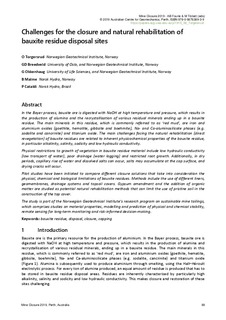| dc.description.abstract | In the Bayer process, bauxite ore is digested with NaOH at high temperature and pressure, which results in the production of alumina and the recrystallisation of various residual minerals ending up in a bauxite residue. The main minerals in this residue, which is commonly referred to as ‘red mud’, are iron and aluminium oxides (goethite, hematite, gibbsite and boehmite), Na- and Ca-aluminosilicate phases (e.g. sodalite and cancrinite) and titanium oxide. The main challenges facing the natural rehabilitation (direct revegetation) of bauxite residues are related to inherent physicochemical properties of the bauxite residue, in particular alkalinity, salinity, sodicity and low hydraulic conductivity. Physical restrictions to growth of vegetation in bauxite residue material include low hydraulic conductivity (low transport of water), poor drainage (water logging) and restricted root growth. Additionally, in dry periods, capillary rise of water and dissolved salts can occur, salts may accumulate at the cap surface, and drying cracks will occur. Pilot studies have been initiated to compare different closure solutions that take into consideration the physical, chemical and biological limitations of bauxite residues. Methods include the use of different liners, geomembranes, drainage systems and topsoil covers. Gypsum amendment and the addition of organic matter are studied as potential natural rehabilitation methods that can limit the use of pristine soil in the construction of the top cover. The study is part of the Norwegian Geotechnical Institute’s research program on sustainable mine tailings, which comprises studies on material properties, modelling and prediction of physical and chemical stability, remote sensing for long-term monitoring and risk-informed decision-making. | |
